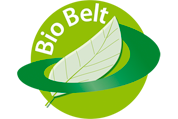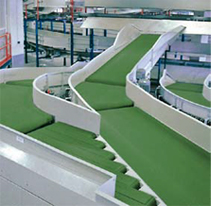Biobelt – Forbo Siegling produces the first sustainable conveyor belt
Forbo Movement Systems showcased the first sustainable conveyor belt at the LogiMAT in Stuttgart. More types, currently in development, will be added to the product range.

Photo by Forbo Siegling GmbH
The new product is made of renewable, biodegradable materials, cuts power consumption and still offers the same characteristics as conventional conveyor belts. Belting specialist Forbo Movement Systems has succeeded in developing sustainable conveyor and processing belts that reduce ecological footprints. With the Biobelt, conveyor operators at distribution centres, airports and automotive manufacturers can now consistently pursue their sustainability concepts. The product is available in different versions, for example with surfaces that are smooth, or with longitudinal grooves for inclined conveying. The range will be showcased for the first time at LogiMAT in Stuttgart (13 to 15 March 2012) in hall 3, stand 261. Further types, presently in development, will be added in the future.

Photo by Forbo Siegling GmbH
Belt exchange without modifying conveyors
“The interest in sustainable conveyor belts is huge, but there have been none on the market to date”, comments Bernd Langreder, logistics segment management at Forbo. “As an innovation leader we’ve pulled out all the stops to find solutions that stand the test of real-world conditions. And we developed Biobelt with our international team of researchers. We believe it’s the first conveyor belt that is made from renewable materials and is biodegradable”. Initial field tests show that the Biobelt series is just as efficient and durable as conventional, wholly synthetic belts. Due to the renewable and biodegradable materials used to make the belts, they also offer real added value. Customers wanting to convert their conveyors to the new Biobelts can do so easily. The belts’ characteristics are the same and furthermore the splices are identical too. All existing mechanical components in the machinery, such as drums, tracking systems or drives, can still be used.

Photo by Forbo Siegling GmbH
Renewable and biodegradable raw materials
The global developer team, spearheaded by Dr. Torsten Buch, replaced the oil-based raw materials and synthetic technical materials with renewable plant-based materials. An already patented special coating can be added to the Biobelts, allowing customers to achieve energy savings of up to 40% (like the Amp Miser concept). This type has already been a market success for several years. Together with the Biobelt concept, it is an ideal and consistent combination.
“The first successful field tests show that along with package sorting and logistics centre, Biobelts can equally be used as baggage conveyor belts at airports”, comments Langreder. “The automotive and other manufacturing industries are also conceivable. Basically, Biobelt is the right product for all companies that advocate sustainability and practise it too”. If the belt has to be exchanged after a few years it is even biodegradable. As a result, Biobelt works on a cradle-to-cradle model. This principle means waste can be utilised for new products, creating an enduring, eco-friendly cycle.
Modular Biobelts
Special, innovative tension members give the belt the required stability across its length and width. Consequently, they guarantee the same physical and dynamic characteristics that conventional conveyor belts offer. In order to tap into as broad a spectrum of applications as possible, the Biobelt concept is modular. Depending on the area used, the components can be modified and enhanced to suit the application concerned. The developers are currently working on a flame-retardant type for airports. A patent is pending for Biobelt.
Visit the online exhibition stand of Forbo on EXPO21XX.com
News Categories
- » NEWS HOME
- » Automation & Robotics
- » Industry 4.0
- » Material Handling
- » Sensors
- » Quality & Testing
- » Machine Vision
- » Laser & Optics
- » Metalworking
- » Motion Control & Drives
- » Hydraulics & Pneumatics
- » Process Industry
- » Renewable Energy
- » Agriculture
- » Home & Office Furniture
- » Environmental Tech



